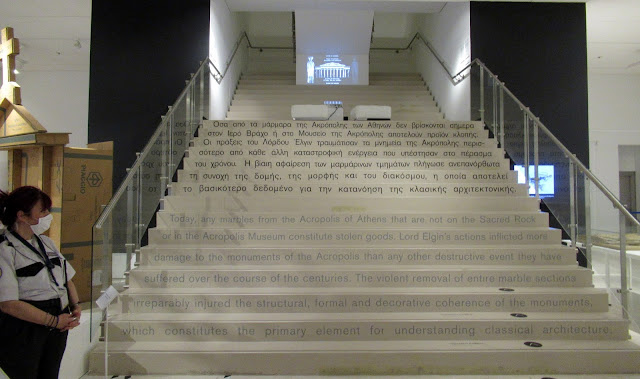'One evening I took Beauty on my lap; and I found it bitter, and I cursed it'. Arthur Rimbaud.
Symbols and Iconic Ruins
at EMST (Museum of Contemporary Art in Athens).
This exhibition is 'an attempt to create a synthesis of different versions of the concept of the symbol, through selected affinities and common features, regardless of whether the sources and production processes of the symbols radically differ from one another', according to the exhibition catalogue.
According to the catalogue, 'the evaluation of a ruin as a symbol is not conditional on the material state of its form. Sometimes remains become symbols and function as such through the preservation of their material aspects, as in the case of the iconic ruins of the Acropolis; other times the construction of monumental structures, as in the case of public buildings of the late-socialist era, produces an intentional symbolism; and sometimes the violent destruction of material, as in the case of the fall of the Berlin Wall, activates the necessary space for the emergence of new, even more powerful symbols. The reframing of all these symbols depends on the ideological transformations along the convoluted paths of history'.
Oops! I did not record the name of the artist.
Konstantinos Papamichalopoulos, Otomo
Michalis Manousakis, The Blue of Kyria Grammatiki
Anna Machairianaki, Exit - Passports please
As always, at EMST, the exhibits are mainly installation - a painting is a rare phenomenon.
Helmer and Aliz (Andreas Sitorengo, Konstantinos Tiligadis), Intangible Victory
Panayotis Pangalos, Nephele Katsarou, Ermioni Syrogiannopoulou, Jimmy Chitas, Chryssa Voudouri, Yiouli Georgosopoulou, Konstantinos Kanellopoulos, After Berlin
'Before I built a wall I'd want to know
What I was walling in or Out,
And to whom I was like to give offence.
(Robert Frost, from 'Mending Wall'.
'The pigeon holds a poorly defined position in the varied history of humankind. Sometimes it appears in art, half dead in the midst of a still life. The artist imagines the pigeon like a huge urban idol, constructed of wire studded with nails, the same wire used to keep pigeons off roofs and their eaves provoking in people a comic and paradoxical disgust. A modest eater of the crumbs and waste of others, the pigeon represents the forgoing of greatness in exchange for a precooked tranquility'.
The text reads: 'Today, any marbles from the Acropolis of Athens that are not on the Sacred Rock or in the Acropolis Museum constitute stolen goods. Lord Elgin's action inflicted more damage to the monuments of the Acropolis than any other destructive event they have suffered over the course of the centuries. The violent removal of entire marble sections irreparably injured the structural, formal and decorative coherence of the monuments, which constitutes the primary element for understanding classical architecture'.
Elias Kafouros, A Bigger Splash Costume
Kafouros here refers to the villas with pools of Southern California, the epitome of a pan-American (and through Hollywood movies, global) model of living. At the same time he pays tribute to both the work of the same name by David Hockney, as well as the sum of the artist's work on the same theme.
Papamichalopoulos paints ruined and dilapidated buildings with exhaustive precision reminiscent of that of European travelers in the 18th and 19th centuries, when they captured the ancient ruins of Greece. In addition, however, Papamichalopoulos' buildings have a look like the WWII German machine gun bunkers in Normandy. Papamichalopulos paints a ruined and desolate city, as if destroyed by an earthquake, a nuclear disaster, an alien invasion or the walls of an oversized monster.
Mario Botta, Fiore di Pietra: Monte Generoso, Switzerland, 2013-1017
The new landmark on the top of Monte Generoso now graces the spot where an early 20th century hotel once stood. The location is extraordinary: a small plateau overlooking the precipice on the north side of the mountain, characterised by a mighty rock with a steep 300-400 metre drop. The impressive rock formation was the deciding factor for creating an octagonal building with individual 'petals'. On the east front this circular crown provides the space for an observation deck that follows the ridge of the mountain. The arrangement of the individual components (or petals) creates a group of five-storey towers that project out slightly, to close again on the upper floors - hence the name Fiore di Pietra, i.e. Stone flower.
Nikos Tranos, Without Logos
Historically, ecclesiastical architecture functioned as a kind of intermediary between this world, which has always been recognised as of very little importance, and the next, for which we had to prepare throughout our lives. Not only though large-scale constructions such as cathedrals, but also small, usually wooden, and essentially portable confessionals, a peculiarity of the Catholic Church not found in either Eastern or Protestant churches.
Tranos constructs a confessional as a building-gate to another world. The promise of happiness offered by religion here is simulated at a bank counter where the believer makes deposits, withdrawals and investments for the future. Paradise can be a kind of real estate, and in fact, the supreme kind, much more valuable and profitable than the famous plots on the moon that some enterprising individuals once tried to sell.
Tranos builds with the poorest, humblest and most recycled materials, according to Arte Povera - creating a social sculpture, as per Beuys. The concept of confession, which is also transferred to psychoanalysis, here finds an ideal listener in the person of the artist, who sometimes performs actions during the course of the exhibition.
Exit, passports please
a long corridor
Passports, walls, borders, limits.
Am I going or coming?
Am I inside or outside?
Why am I prevented from passing as a stranger?
With or without a Mask?




































No comments:
Post a Comment